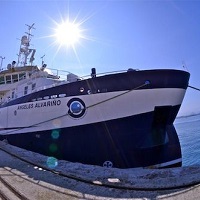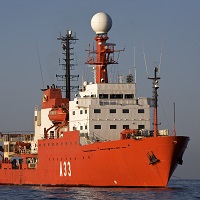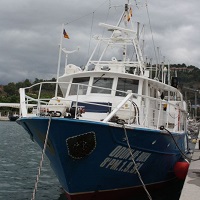Keyword
Las Palmas
47 record(s)
Type of resources
Categories
Topics
INSPIRE themes
Keywords
Contact for the resource
Provided by
Years
Formats
Status
-

Survey belong to the bathymetric studies of Canary Islands
-
It was conducted by the ICCM with the main objective to collect observations in the Canary Islands marine environment; to the north by making the monthly visit to the ESTOC site, and to the south to study the dinamicity in the water column due to the arrival of different water masses and the African coastal upwelling.\n1. To comply with the monthly sampling at the ESTOC station 812. Data was taken to 3700 m at 24 depths from surface to bottom making two profiles, since there was only available a rosette with 12 bottles of 10 l. Samples for oxygen, carbon system, nutrients, gelbstoff, salinity and chlorophyll 'a' (the later to 200m) were taken.\n2. Deploy of two drifting buoys from NOAA (National Oceanographic and Atmospheric Administration, USA) at stations 812 (ESTOC) and 824 (eddy), as part of the collaboration between the ICCM and NOAA to study the surface currents in the Canary Islands environment.\n3. Carry out hydrographic investigations in the triangle area enclosed by the south of the Canary Islands. A total of 23 CTD/rosette stations were made, casting two profiles per station (2000-200m, 200-5m); it provided enough data to characterize the water column. Samples for oxygen, the carbon system, nutrients, gelbstoff, salinity and chlorophyll 'a' (the later to 200m) were taken.\n4. Deploy of 3 ARGOS floats at stations 818, 835 and 843 .\n5. Drop 8 expandable bathythermograph to thermally characterise the extent of the eddy supposed to be located at station 824.
-

This campaign is part of the experimental work that has been carried out in this area since 1996, as part of the CANIGO international and multidisciplinary project (financed by the European Union), as well as the FONDEBC project (financed by the IEO) and now part of the project CORICA approved by the National R + D + I Program in December 2001. The main objective of the subproject is to study, define, measure and model the movements of the water masses that are present in the eastern part of the subtropical turn of the North Atlantic, with special detail in the northward current of the Antarctic Intermediate Water (AAIW) and its interaction with Mediterranean Water (MW), to assess its importance in the transport of energy within the global climate. Goals:Due to incidents in the Gyroscope Campaign, the restructuring of the campaign plan that best suited itself was determined. The main objective was the funding of two series of current meters for the continuous hydrographic study of currents in a specific area of the Canary archipelago.
-

- Informacion en tiempo real de las estructuras de temperatura y salinidad de las capas superiores e intermedias de los oceanos.\n- Variabilidad de masas de aguas y calculos de transportes.Gyroscope
-

The test cruise of the Bathypelagic project (Bathytest) was carried out to the south of Gran Canaria and consisted in two oceanographic stations over 300 and 1000 meters depth in order to test the video camara system installed on the rosette and developed by the University of Las Palmas (Canary Islands). Different tests were performed in order to capture images at different wavelengths to find the best image quality and avoid scapement of organisms as much as possible. Day and night casts were performed. Zooplankton nets deployments (WP-2) were made also during day and nightime.
-

The goals of this survey are framed within the educational activity of the Faculty of Marine Sciences ULPGC to give the possibility of a complete oceanographic study (Physical , Chemical , Biological and Geological Survey ) in the south of Gran Canaria students of Degree, Bachelor and Master , the convergence zone between the area and the trail of the island and the presence of permanent rotation south of it. Thus this survey will contribute to a comprehensive training for students in oceanographic study of an oceanic region may Determine the structure of water bodies, the effects of convergence and divergence to the passage of the Canary Current across the channels between islands, mass transport , and nutrients. Determine the distribution of chemical species , including oxygen and carbon dioxide system and quantify the transport of CO2 in the atmosphere-ocean study area , the effect of micro and mesoscale phenomena in their distribution. To characterize the effect of the wake , turns and other mesoscale structures in the distribution of species of phytoplankton and zooplankton.
-
Timing and frequency of landslide and gravity flow geohazards along the eastern North Atlantic continental margin This research cruise was a contribution towards the NERC strategic science programme (Oceans 2025). The main scientific objective was to improve our understanding of landslide and gravity flow geohazards along the eastern North Atlantic margin, in particular by studying event timing and frequency in the recent geological record. Special attention was being paid to geohazards that may potentially impact UK communities and infrastructure. Shallow piston coring of turbidite successions in deep basins produces the best record of recent (<50 kyrs) gravity flow events on adjacent margins (e.g. Weaver et al., 2000), but the availability of pre-existing data from the study area was patchy. Consequently, a key aim of JC027 was to 'fill the gaps' and recover cores from basins, or sections of basins, where data are urgently required. A total of 60 piston and megacores was successfully recovered during the cruise, from a series of lower canyon and basin floor environments. Shallow geophysical data, including subbottom profiles and hull-mounted multibeam bathymetry, were collected quasi-continuously during the cruise to define local environment around core sites. In complex areas, such as seafloor scours, Autosub6000 was deployed to collect high-resolution EM2000 multibeam bathymetry.
-

- Levantamientos hidrograficos sistematicos y exhaustivos que permitan el cartografiado total de sus fondos\n- Realizar exploraciones geofisicas que permitan determinar su constitucion y fisiografia \n- Llevar acabo coampa?as oceanograficas sistematicas para el estudio de los procesos fisicos\n- Procesar y tratar los datos obtenidos en las campa?as para la obtencion de mapas, cartas e informesen los cuales se definan las caracteristicas y el potencial economico de la ZEE\n- Hacer tratamiento informatico necesario para la integracion de datos en bancos de datos interactivos.\n- Poner a disposicion de la comunidad cientifica e industrial toda la informacion, salvo la restringida por afectar a la seguridad nacional.
-

Recogida de datos fisico-quimico-biologicos en toda la columna de agua para obtener series de datos suficientemente representativos que permitan afrontar estudios relacionados con el cambio climatico, a partir de diferentes variables Oceanograficas. Igualmente, la informacion obtenida contribuira a definir la climatologia y anomalias asociadas al litoral Mediterraneo espa?ol y tan importantes en estudios de esta indole.
-
<p>Understanding the ecosystems of hydrothermal sites and their surrounding areas in the Atlantic: mapping and characterization of the geological and geochemical context, characterization of habitats, inventory of biodiversity in hydrothermal ecosystems and surrounding areas and geobiological connectivity and interaction.</p>
 Catálogo de datos del IEO
Catálogo de datos del IEO